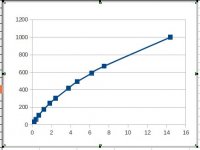roycruse
Member
OK I just tested a couple of Thumper V2 2836-11 motors on 3S with 13X6.5 props with the following results.
Full throttle single motor 14.5 AMPs with almost exactly 1000g of thrust.
when i ran 2 motors bolted one above the other one with a pusher I still was getting 1900g of thrust at full throttle which surprised me.
what surprised me even more was that on measuring the current to each individual motor they are still drawing aprox 15 amps each.
1. I expected them to be sharing the workload of pushing the air and for it to not be anywhere near 2000g of thrust
2. I therefore expected the current of both motors to be less than when run individually
3. I expected the motor downstream of the airflow to be pulling considerably less amps than the other
any comments or discussion points welcome
how does this motor / prop setup sound for a Y6 copter ie 3 times this tested setup.
I did a plot of current vs thrust for a single motor - things was getting a bit hairy to do it with the 2 but i may try again tomorrow, if i can get my son to volunteer to help me, but this was the plot i got for the single motor - (does it seem an acceptable setup for multi rotor use)
View attachment 1307
Full throttle single motor 14.5 AMPs with almost exactly 1000g of thrust.
when i ran 2 motors bolted one above the other one with a pusher I still was getting 1900g of thrust at full throttle which surprised me.
what surprised me even more was that on measuring the current to each individual motor they are still drawing aprox 15 amps each.
1. I expected them to be sharing the workload of pushing the air and for it to not be anywhere near 2000g of thrust
2. I therefore expected the current of both motors to be less than when run individually
3. I expected the motor downstream of the airflow to be pulling considerably less amps than the other
any comments or discussion points welcome
how does this motor / prop setup sound for a Y6 copter ie 3 times this tested setup.
I did a plot of current vs thrust for a single motor - things was getting a bit hairy to do it with the 2 but i may try again tomorrow, if i can get my son to volunteer to help me, but this was the plot i got for the single motor - (does it seem an acceptable setup for multi rotor use)
View attachment 1307
Attachments
Last edited by a moderator:

